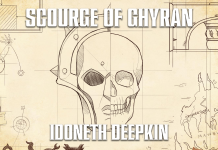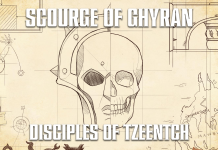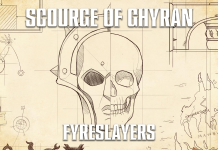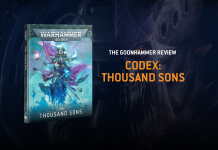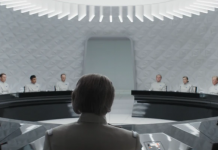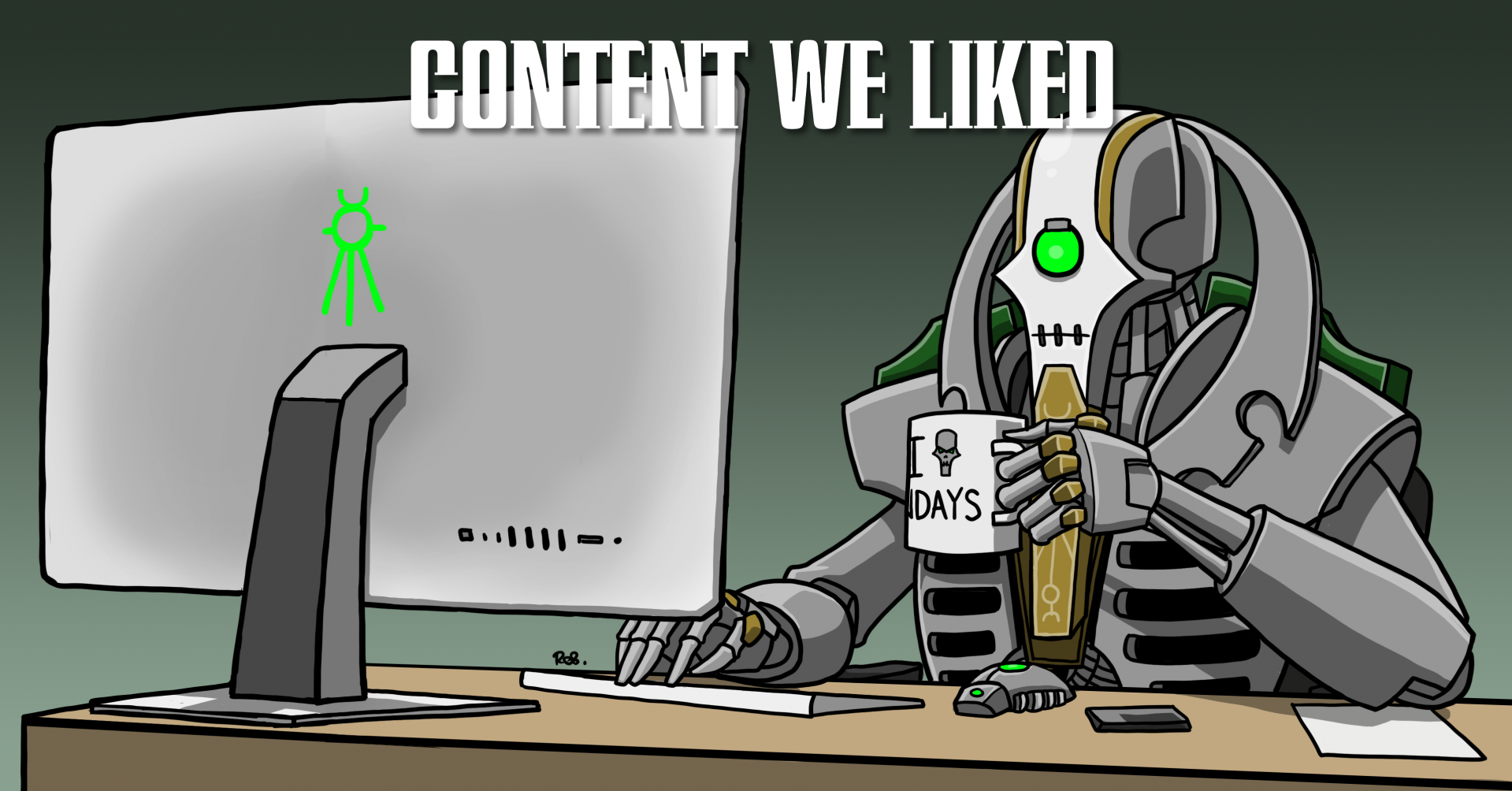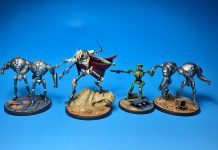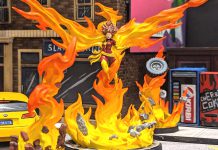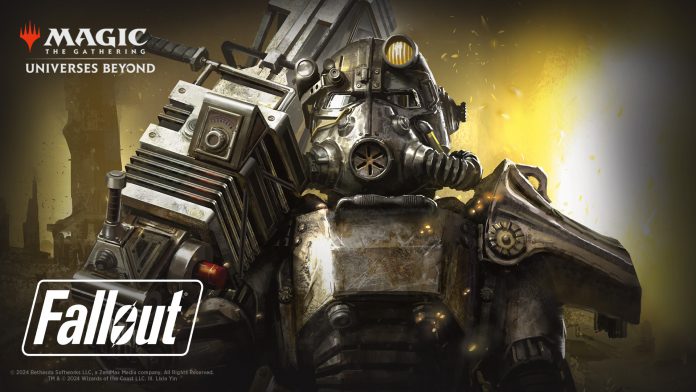Today we have a slight departure from usual, diving in to review ALL of the new cards from the fourth and final of the Fallout preconstructed Commander decks. While many of us are big Fallout fans, we’re mostly focusing on the cards and their use in the game of Magic in and out of the deck itself.
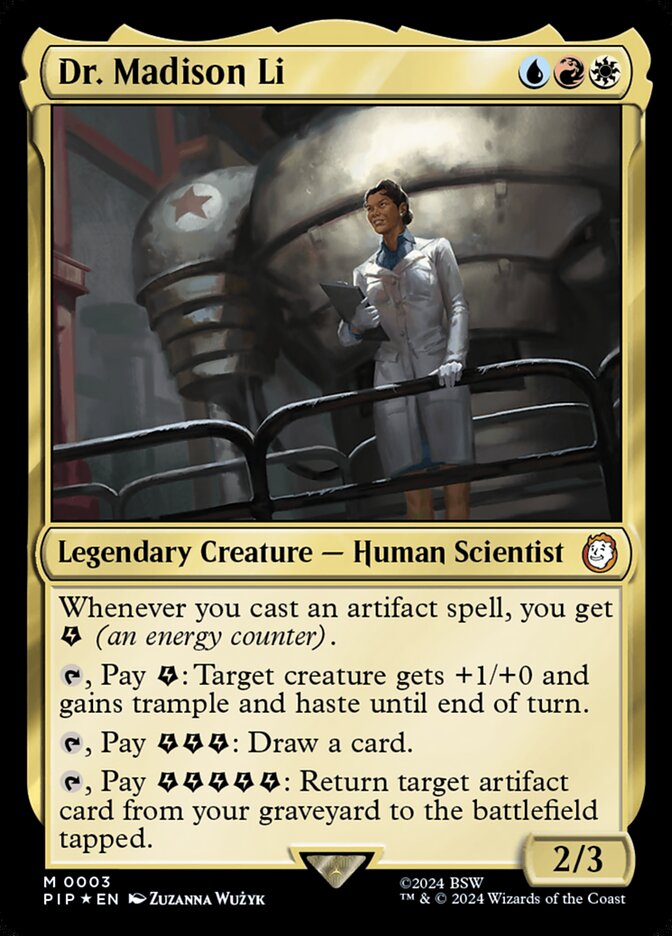
Dr. Madison Li
Steel Mentor: Dr Li first shows up in Fallout 3, acting as a quest giver around the third way mark of the main campaign. A scientist on Project Purity alongside the player character’s father she… sure is a character? I’m sure there’s some diehard Dr Li fans out there but she was always kinda a flat character to me, even amongst Fallout 3’s massive stockpile of flat characters. Apparently she was popular enough to come back for Fallout 4, and be a face Commander for this deck, where she serves as your Energy generator option, I guess stemming from her expertise with advanced tech systems. What a weird choice for such a prominent card.
BPhillipYork: Neat to see an energy based commander, this is something that’s been a difficult to build around a mechanic. I’m not entirely sure it was necessary, it’s not like someone is rushing to put out an Orzhov shadow or Esper shadow commander because, ugh. This is definitely breakable, there’s loops you can build around artifacts entering play over and over, cost reduction, Jhoira, Weatherlight Captain combined with white is a pretty sick color spread. So, go forth make a jerkoff artifact deck, if you want.
Marcy: Energy is back, baby, and, uh… well, it’s back. I think the problem with Energy is that it has always done either nothing, or led to incredibly spin-to-win plays (like with Aetherworks Marvel). I like this card, though, because she actually helps you generate Energy, and also gives you a lot of options for spending Energy.
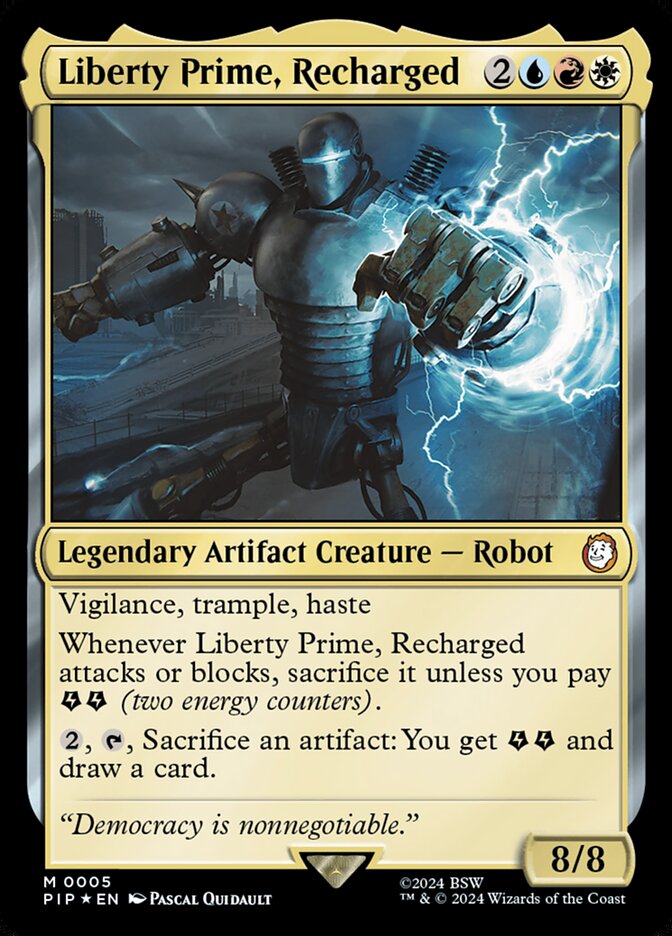
Liberty Prime, Recharged
Steel Mentor: Now here’s a character people were salivating for the moment this crossover was announced. Liberty Prime is a Pre-War terror weapon that was built but never managed to be deployed before the bombs dropped. He screams anti-communist slogans, he tosses nukes like footballs, he has eye lasers, he is the bluntest piece of goofy satire in possibly the entire series.
Design wise… he’s a giant robot, with a giant robot body and aggressive set of keywords to boot. His drawback stems from a plot point mentioned at multiple times that his power systems are desperately inefficient and leave him out of the fight, conveniently until the story needs some obstacle smashed out of the way. I’m sure we’ll see a lot of him on tables for the foreseeable future, from hot blooded patriots who just can’t stop themselves from quoting him, endlessly.
BPhillipYork: Yeah this is more fun. Also lots of bonus points if you memorize Liberty Prime’s voice lines, or even build a soundboard. An 8/8 Vigilance, Trample, Haste robot built around a mostly forgotten mechanic is totally what commander is about. Feed it artifacts to build up energy and kill, it’s very Fallout-esque, and fits nicely into commander. So this is like the good kind of bad card that’s fun to build around, nice to see.
Marcy: As the ‘secondary’ commander in this deck, I actually don’t like this card very much as a commander. Liberty Prime is absolutely a beater, but with no way to protect itself, you’re mostly just swinging with an 8/8 for five mana that might also cause you to sacrifice it at the end of the turn. In other formats, a swinging, hasted 8/8 is scary, but in Commander, it really isn’t that game ending.
FromTheShire: Great commander, trample and haste means that even if this is repeatedly removed you can just recast it and swing again immediately to trample through with big commander damage. The vigilance is excellent as well since not only does it hang back as a huge blocker, it also opens up little tricks like being able to tap it and sacrifice an artifact after it is declared as attacking in response to its own trigger to give you the necessary energy.
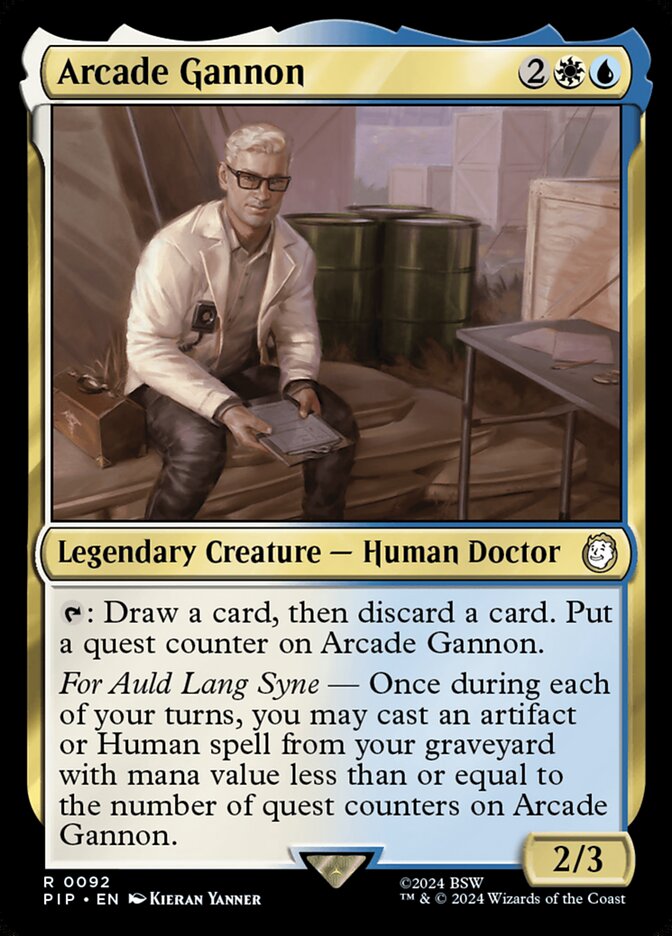
Arcade Gannon
Steel Mentor: Another New Vegas companion, a doctor and member of the Followers of the Apocalypse, Arcade is a man running away from his past like many who come to the Mojave. I’m hesitant to say much more about him because his questline is real real good, and I’d recommend you at least look up a video of it or just go play New Vegas like, now. Go play it. Anyway, speaking of that questline, this card does a pretty good job and replicating the very broad strokes of its structure, digging up old tech and old faces from Gannon’s past the more time he spends with you, the player. Very cool card for a very cool character.
BPhillipYork: Neato, fits nicely into these themes of playing artifacts for energy, especially if you use eggs (the series of artifacts that do something on cast/enter and leaving the battlefield) and pair it with cost reduction.
Marcy: Looting in UW colors is really interesting, especially because Arcade has the potential to allow you to cycle things in and out of your graveyard easily if he isn’t removed. It’s important to note that he doesn’t lose the counters when you use the ability, meaning that you can take advantage of the ability as you ramp up to the desired amount of counters you want (assuming you can’t get them on him immediately). A lot of artifact based decks in Commander want to be recursive, and Arcade does offer some new ability to do so.
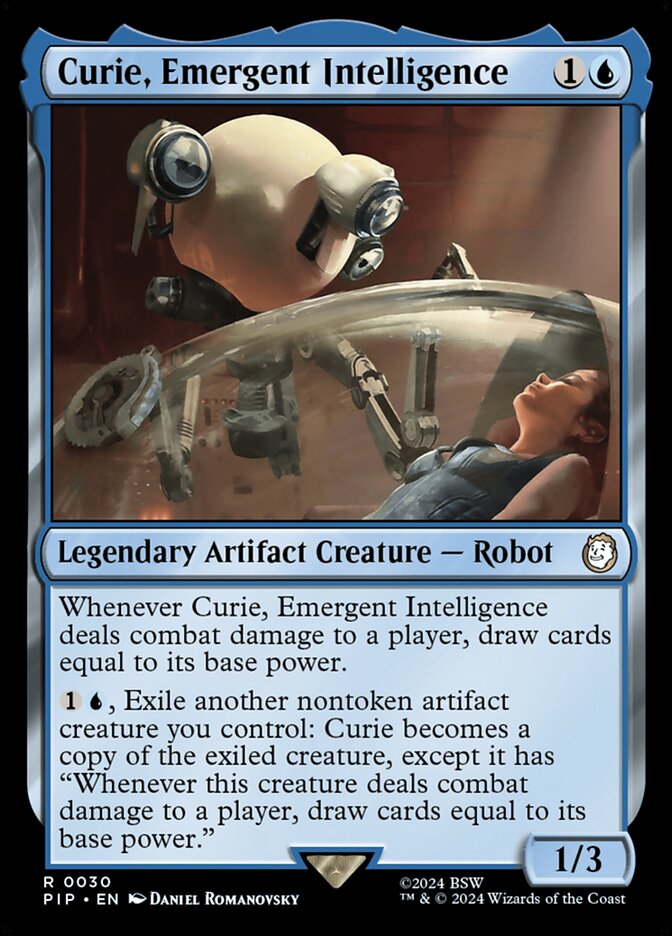
Curie, Emergent Intelligence
Steel Mentor: A unique Miss Nanny model robot designed to aid the science staff of Boston’s Vault 81, Curie was tasked with helping create a global cure to any and all disease. After spending several hundred years locked alone inside the Vault after its residents all died, she actually succeeded and developed free will in the process. Curie is a potential companion in Fallout 4, and like so many other companions in this crossover her card design reflects her questline, where the player attempts to help Curie find a suitable humanoid body to upload herself into. Exiling creatures is a pretty good way to represent this, a solid B grade flavour design.
BPhillipYork: Well that’s a bit of a stretch but sure, it’s a draw engine with no evasion that costs 2 mana and 2 more mana and requires you to dump another card. Best case scenario you cast Phyrexian Dreadnought, throw the sacrifice on the stack, exile with Curie in response, then you have a 12/12 where you draw 12 every time it deals combat damage to a player (double strike means 24) which is a a neat thing.
Marcy: This deck honestly has some of the most interesting cards in the set, in my opinion. It sounds a little odd to exile another creature off the board, especially one likely with higher power than a 1/3, but there seems like some potential to maybe have fun with this card somehow.
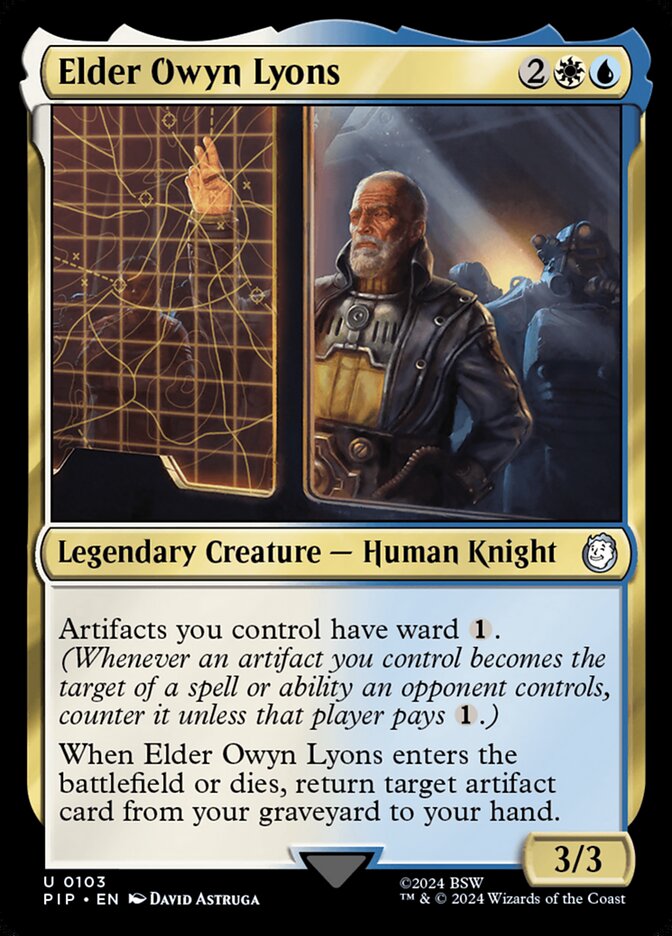
Elder Owyn Lyons
Steel Mentor: Head of the East Coast Brotherhood of Steel at the time of Fallout 3, Lyons was a man harrowed by the horrors he witnessed leading his chapter of the Brotherhood from California to the Capital Wasteland, with the cruelties he witnessed in Pittsburgh in particular making him completely rethink the Brotherhood’s philosophies of hoarding tech and isolationism, though marking him and his followers as traitors to the cause in the process.
Despite his iconoclastic leanings, Lyons’ card design leans… pretty orthodox for what you might expect Brotherhood flavoured card design to be. He recovers artefacts and protects them, which feels a little at odds with his characterisation of leaning more towards using tech to protect others, but it works I suppose.
BPhillipYork: Ward 1 is uh, neat but not for 4 mana, since most of the time you’ve got artifacts getting mass removed if removed at all, or deactivated with Null Rod. Fetching back 1 artifact just isn’t enough for that mana cost.
Marcy: A nice sort of ‘lord’, not in that he buffs, but protects, artifacts; ward 1 may not seem like a lot, but it can throw a wrench into things; the fact that he helps you out when he dies as well by returning something to your hand makes taking him out with removal a less positive trade for your opponent.
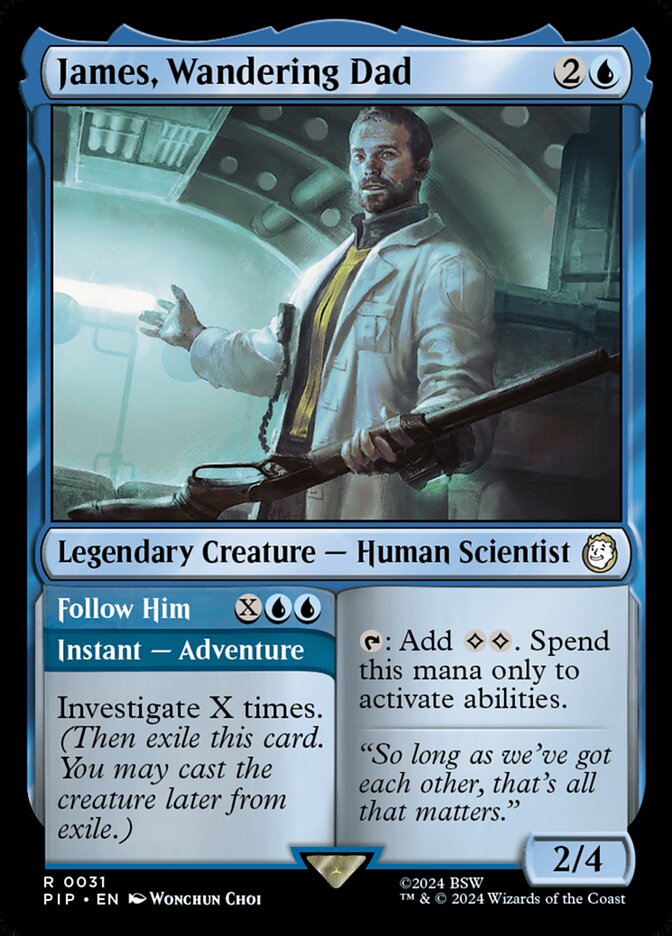
James, Wandering Dad
Steel Mentor: Hey look, its Qui-Gon Jinn! Looks like we got Universes Beyond: Star Wars early!
Lame jokes aside, James is the player character’s father in Fallout 3, voiced for what little time we see him by Liam Neeson. Head of Project Purity, James abandoned the mission to bring clean water to the Capital Wasteland after the death of his wife during childbirth, taking their newborn and bartering for entry into Vault 101, before mysteriously breaking out of the Vault two decades later and kicking off the game’s campaign. The Adventure mechanic is used pretty well here to theme out the main quest of Fallout 3’s first half, trying to track him down across the Wasteland, while the creature side of him is… kinda whatever. He’s a mana dork for abilities. Half a cool card at least.
BPhillipYork: Well I like commanders with adventures, fits Fallout nicely, 2 colorless and 1 blue for a Worn Powerstone is fine if you really want that. The investigate and then having it tap for 2 mana is nice both sides of the trick-dom but the trick just isn’t good enough. As a commander this just doesn’t cut it.
Marcy: Generating a lot of Clue tokens might be valuable, but this deck (and many Blue and Blue-adjacent artifact decks) really just want to generate tokens, which this can do fairly easily perhaps right before your next turn. It’s likely a very expensive way to try and draw cards (you’d need 5 mana just to draw one card), but token generation is token generation. The ability on the creature itself is kind of odd, making it only useful in decks that require activation costs.
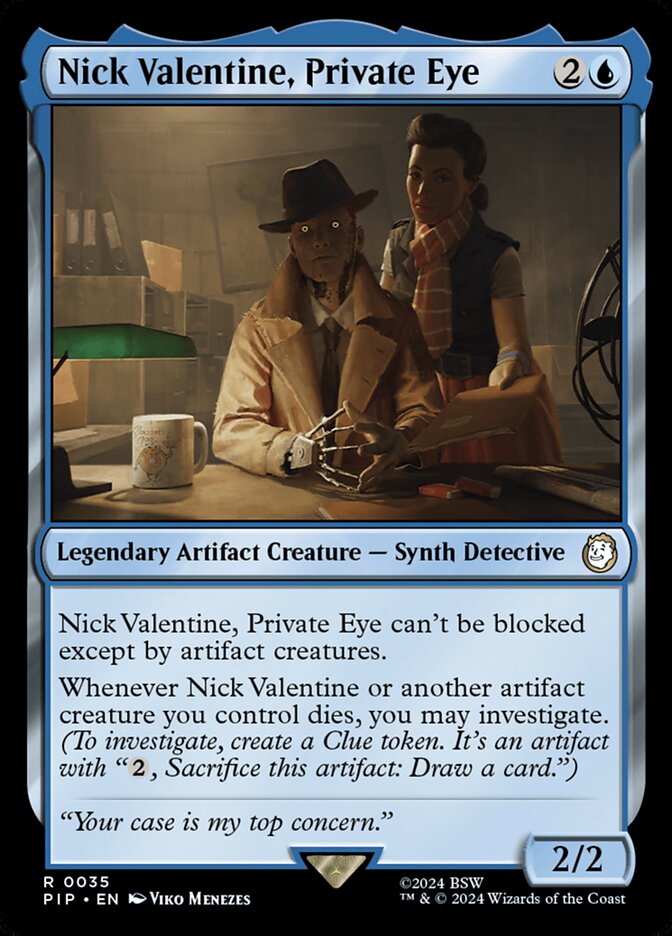
Nick Valentine, Private Eye
Steel Mentor: Another Fallout 4 companion, and pretty easily its most popular one at that. Nick is a Synth, an advanced robot meant to mimic humans more closely created by Fallout 4’s villains, The Institute. Given the personality of a pre-War cop before being thrown out with the trash as a failed experiment, Nick’s skills managed to endear him to the residents of Diamond City where he runs a detectives’ office the player character is guided to in the search for their missing son. He’s… a detective, and he investigates. Another one for the pile we just got with Markovs at Karlov Manor. Kinda disappointing outside of his unusual evasion in terms of flavour.
BPhillipYork: So this will go infinite with creating tokens under certain circumstances, which is a bit of a thing (all artifacts you control must be creatures, with toughness = to casting cost, so March of the Machines) since it’s a may this doesn’t create a forced loop and a forced draw, though you can choose to just force a draw with it. But if you are generating a ping each time or something then, this is somewhat dangerous. Also I feel like Nick should do something each time you investigate, Piper is the one who should generate clues.
Marcy: A fairly unique type of evasion, but otherwise Nick doesn’t really do very much else. Certainly makes it easy for him to get in against most decks, though, which might be annoying enough; giving other creatures the ability to generate tokens is nice, but I feel like poor Nick might just eat cheap removal and not accomplish a lot.
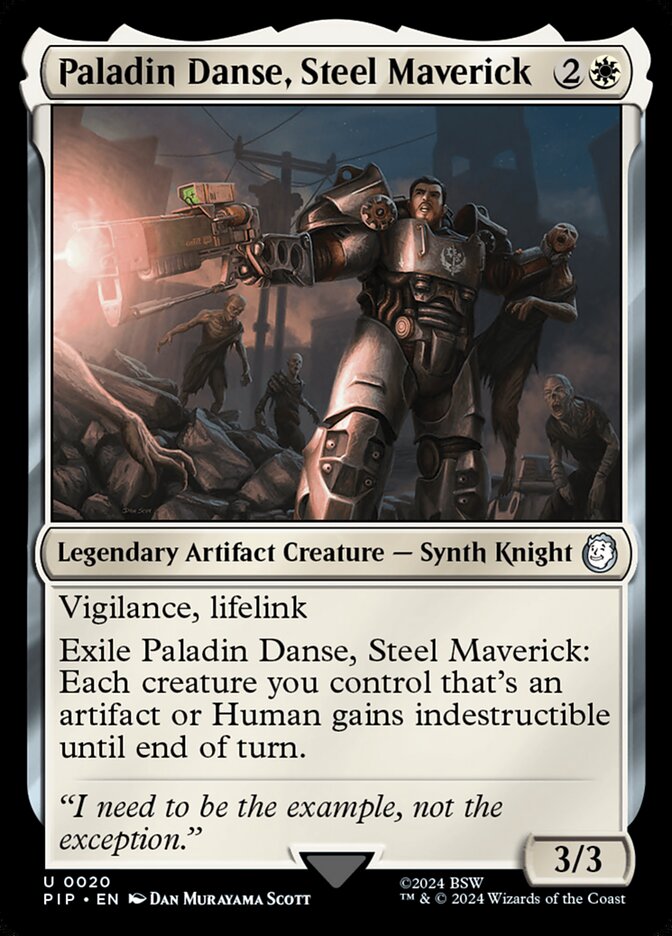
Paladin Danse, Steel Maverick
Steel Mentor: Yet another Fallout 4 companion, Danse is a member of the Brotherhood and the knightiest knight to ever knight amongst his brothers and sisters. As his card types spoil he’s also a Synth, with his companion quest centring around proving whether or not his dedication to the Brotherhood and its goals is genuine or pure fabrication. His second ability kinda reflects one of the possible outcome of that questline, but it’s kinda another one you gotta squint at a little.
BPhillipYork: Well this is fairly solid protective card to run, a lot of things care about artifacts and this lets you protect your board from a board wipe, so for white weenie this is really nice to have (or any kind of white go-wide).
Marcy: A fairly strong card with good abilities of his own, he’s similar in some ways to Boromir, Warden of the Tower, except specifically only protecting artifact and human creatures, so kind of less good. In this deck, though, he’s pretty ok!
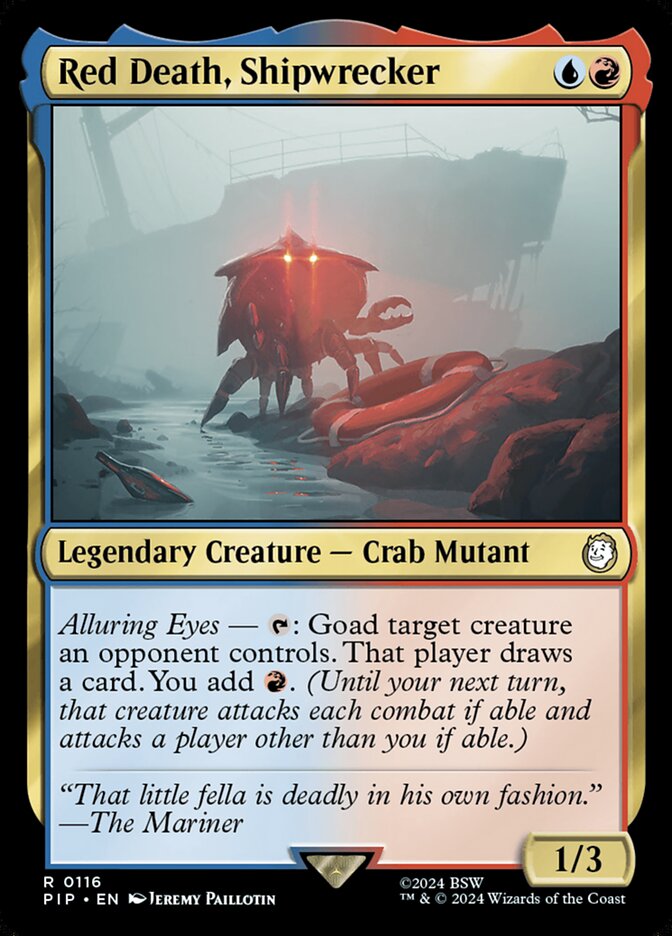
Red Death, Shipwrecker
Steel Mentor: A very cute card that just… doesn’t really fit this deck. He really needed to be a Red card huh. Like seriously he could have been mono-blue or Simic and you could have swapped him into the Mutant precon for Piper. Such a shame. Red Death is a legendary Mirelurk from the island chain of Far Harbour in Fallout 4’s DLC of the same name, his glowing eyes bright enough to pierce through the unnatural Fog that blankets the islands. Inadvertently, this usually results in hapless captains running their ships right into the rocks surrounding Red Death’s favourite lurking spot as they try and navigate through the adverse conditions. A neat card hamstrung by colour identity shenanigans.
BPhillipYork: Yeah this is totally breakable, pretty easily. Umbral Mantle + Power Artifact means you can uh, deck all your opponents. There are other more complex ways to break this, which is kind of weird. It’s not a terrible card to just have, in general terms, especially in group hug you to death decks, though red and blue aren’t that typical in those decks (well blue is) so, nice to see more balanced goad cards I guess.
Marcy: I was going to comment that this deck has really solid theme in the cards so far, and then this card just kind of wanders out of nowhere. Red Death doesn’t really fit any of the other cards around it, but the card itself is really kind of interesting on its own. Forcing interaction amongst your opponents while generating you mana and forcing the player to draw a card sounds like a really, really weird way to force an opponent to mill themselves out of the game, if you had a way to endlessly tap and untap Red Death and had legal targets.
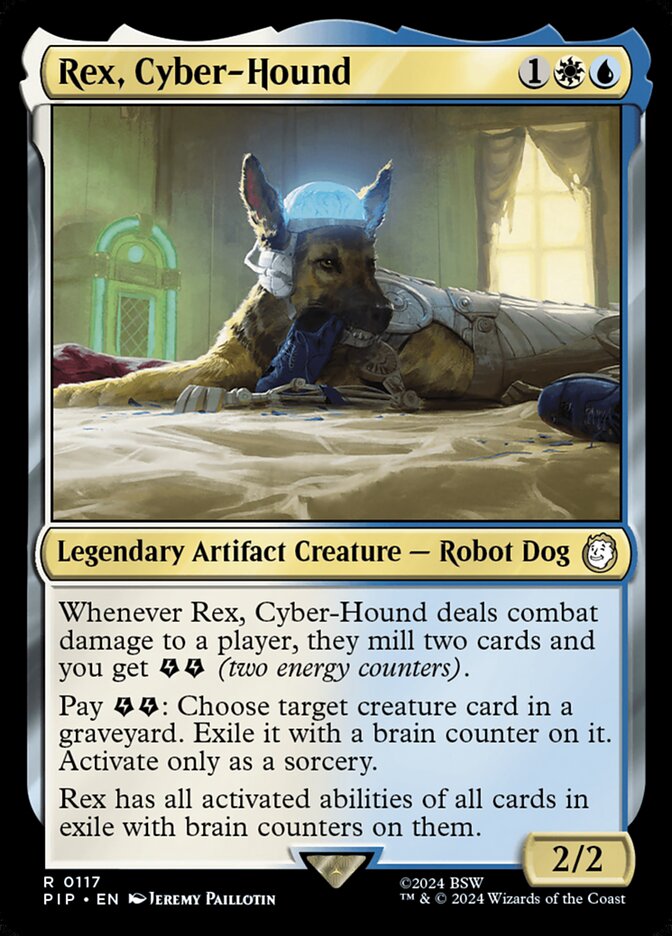
Rex, Cyber-Hound
Steel Mentor: Now Rex is much more than just a hound dog. Rex is a Cyberhound, a cybernetic pooch owned by The King, an Elvis impersonating gang leader players meet in New Vegas’s slums. Rex can be recruited as a companion if you help The King deal with some troubles going on in his turf, with his companion quest sending you on a search around the Mojave to find a replacement brain to swap for his degrading old one. As part of the outcomes of that quest, Rex can receive different buffs and drawbacks depending on which brain you ultimately jam into him, represented on his card in a pretty slick way by letting him steal the abilities of creatures you exile with his Energy ability. This is real neat, real damn neat.
BPhillipYork: Well this definitely maps out the quest, and has both sides of the trick on it, and is… fine. I mean fine if you want some graveyard hate, doesn’t do too much on its own, though you can exile Asmodeus the Archfiend as probably the go to here, but then that’s totally out of your blue/white color scheme so this is just a sideline in an Esper.
Marcy: So, Rex generates the energy needed to use his own ability (assuming he doesn’t die in that combat), and you can then exile any creature card–not just your own–and grow Rex into a fairly disgusting sort of combo machine. Obviously he doesn’t protect himself, and can get killed off fairly quickly, but Rex is going to be limited by your ability to generate Energy and then snap up target cards, which is quite a lot of work.
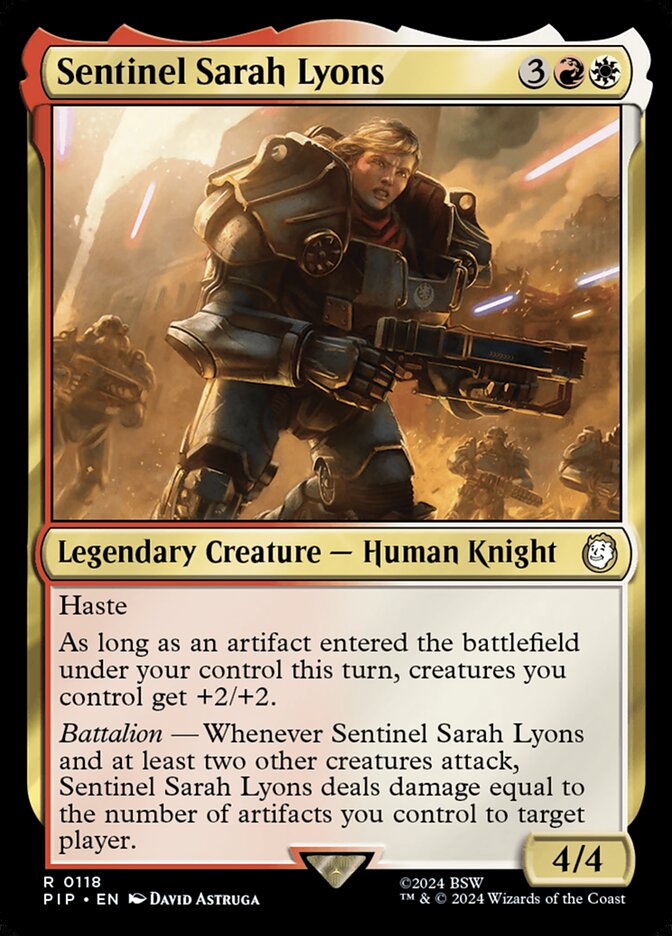
Sentinel Sarah Lyons
BPhillipYork: So this will pair really well with Alibou, Ancient Witness for some kind of Boros artifacts deck which is cool enough, equipment and hopefully Bludgeon Brawl and a ton of ramp and just whatever. Go hog wild if that appeals to you.
Marcy: Somewhat ironic in that Sarah’s abilities work really well with cards from the Caesar deck, but this deck has quite a lot of ways to generate artifacts easily, meaning that it is very likely Sarah enters as a 6/6 and then boosts all of your other creatures. And, this might be a hot take, I think she’s a better card than Liberty Prime at this mana cost.
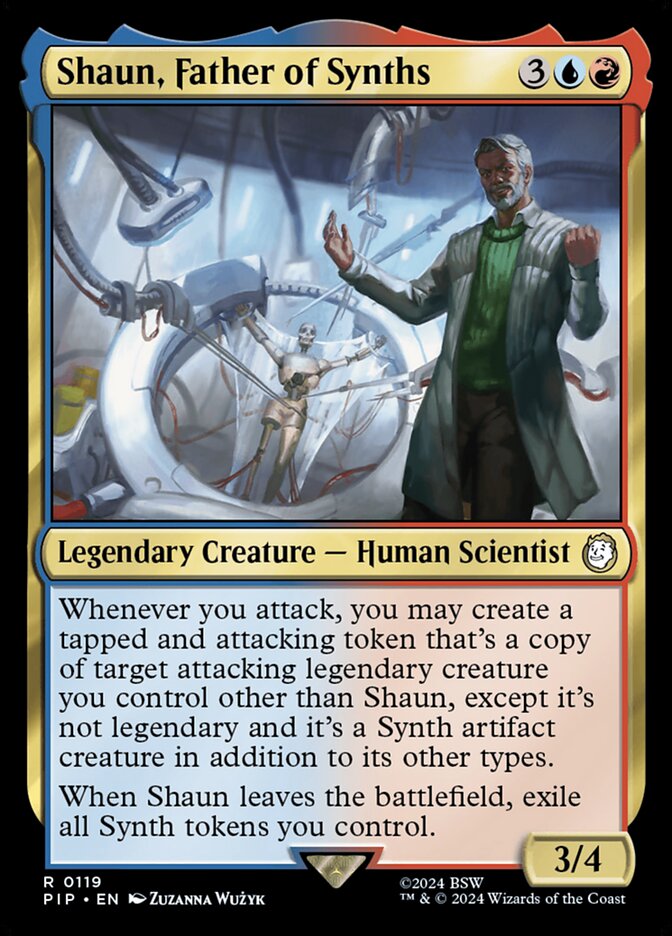
Shaun, Father of Synths
BPhillipYork: Neato for creating an army, a bit dangerous because of the potential to create loops with additional combats with some of the legendaries like Eomer, Marshal of Rohan and Aurelia the Warleader; a bit more difficult to work the triggers and deal with creatures that enter attacking vs actually attack, but definitely ways to create a loop with clever sacrificing.
Marcy: I’m sure there’s no way at all this card could cause lots of degenerative combos! Anyway, pretty good. Attacking is required to trigger, but Shaun himself doesn’t need to attack, which is fitting for the character as well as for the effect. Also, since the tokens aren’t legendary, you can just keep copying the same one, or copy multiple different ones, meaning that Shaun becomes a primary target for removal, and also likely for you to protect.

The Motherlode, Excavator
Steel Mentor: Man, I know Fallout 76 doesn’t have many characters to draw on but this… is a little left field. The Motherlode is a series of linked mining robots created by the Appalachia based Hornwright Industrial company as part of their push to completely automate West Virginia’s mining industry. A massive drain on the company’s resources, the project became a white whale for the increasingly unstable CEO after his wife’s death. The Motherlode is the subject of a side-quest in 76 and a series of random events out in the overworld. And that’s kinda it? Weird choice for a slot. It’s responsible for a bunch of ecological damage to Appalachia (hence its land destruction suite of abilities) but that’s not that notable in my option. A big ol’ shrug.
BPhillipYork: Wow this is dangerous, repeatable land destruction is strong, and dangerous, and totally so hated on that people won’t play it, but they should. And honestly, for 5 mana blowing up a land every turn with multiple moving pieces isn’t that strong.
Marcy: Land hate on a beefy body? That’s just mean. I love it. 4 Energy is a ‘lot’, if you don’t have ways of generating more of it, and while blowing up a single land a turn might seem slow, it is annoying, and Commander runs a lot of nonbasics.
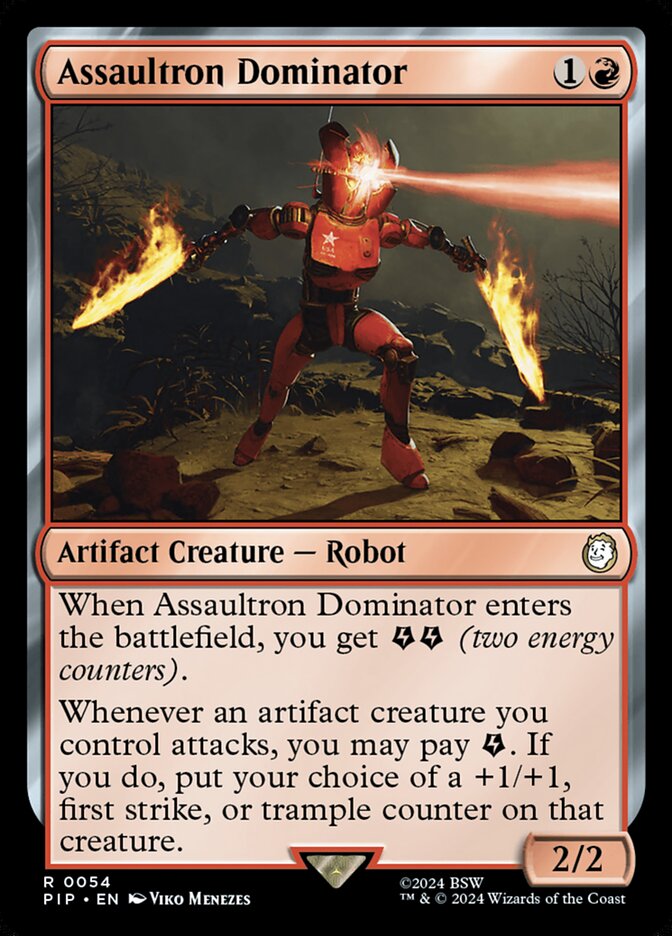
Assaultron Dominator
Steel Mentor: A humanoid combat robot created by the robotics pioneers RobCo industries, Assaultrons were introduced into the series in Fallout 4, particularly having their day in the sun in the Automatron DLC pack. The Dominator variant packs a pair of flaming swords to back up its stock eye-laser, as well as a stealth device that allows it to close the gap on targets before it skewers them through. With that kind of capabilities spread, its on card abilities feel a little generic. Would have been a cleaner flavour representation if it only buffed itself up on top of the keywords, but whatever. It’s fine.
BPhillipYork: Neat. Really neat, flexible counters and an outlet for all this energy is really solid, 2 mana for that is a just solid enabler for a mechanics based deck.
Marcy: If your deck can generate energy efficiently, this little guy can become quite a menace. You don’t have to just pick one, and you could spend as much energy as you have to pay.

Automated Assembly Line
BPhillipYork: Another quite solid enabler for energy deck, which I really like to see.
Marcy: Again, if you do generate energy efficiently, you can really cause some problems here by popping out 3/3s fairly easily.
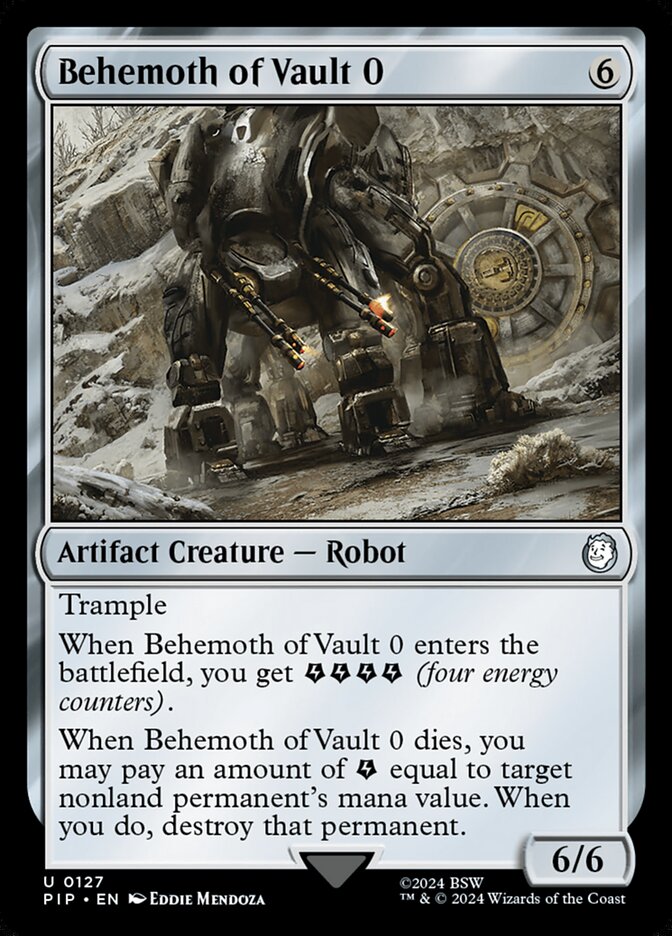
Behemoth of Vault 0
Steel Mentor: I was… genuinely shocked to see a Fallout: Tactics themed card in this set. It’s a game Bethesda generally just doesn’t mention often (and considering some of the writing, I can’t blame them), though it hasn’t been completely un-personed out the series like that one Xbox game was.
Anyway, Vault 0 was a special command node of the Vault system located in Colorado. Housing the cryogenically frozen brains of geniuses linked to a massive central supercomputer known as The Calculator. Naturally something so cartoonishly supervillain evil went wrong, with The Calculator going insane and building a robot army to purge the surface. The Behemoth is the largest of its creations, serving as a boss then mini-boss towards the finale of the game. It’s a big robot and it blows up good, that’s the flavour.
BPhillipYork: Too expensive but on theme for the your energy artifact creatures deck. Way weaker than say, Meteor Golem. Only real upside here is if you have an ability to flicker this or repeatedly have it enter play, but Meteor Golem is again, the same thing, except, simpler.
Marcy: A 6/6 for 6 that gives you some energy, and then gives you a chance to blow something up, if you have the energy to spend. Of course, as this is an ETB trigger, you probably want to find a way to not have to pay 6 actual mana for this card, in which case it’s value would increase quite a bit more.

Bottle-Cap Blast
Steel Mentor: Improvised explosives are a handy lil’ tool in the Wastelands, with Bottle-Caps being an effective load of shrapnel to stuff inside a suitable shell, like an old metal Lunchbox or the like. While this tends to ruin the value of the caps as a currency, you can’t deny the results.
BPhillipYork: I like this a lot, generating a ton of Treasures is really valuable sometimes, and it has improvise, so it’s expensive, but this is an awesome enabling piece for artifact token based decks that need to make even more tokens (so like Galazaeth Prismari).
Marcy: If you have a lot of cheap artifacts and/or tokens lying around, this is basically a 1 mana 5 damage instant that potentially generates more mana for you, so that’s a pretty solid spell. Affinity would love this, probably.

Brotherhood Scribe
BPhillipYork: So, fine, but also kind of dangerous generating tons of energy often isn’t that hard at once, and pumping a horde of small artifact creatures could get you to lethal quickly. 3 toughness is nice to move out of a lot of but not the best damage based board clear, so decent all around enabling piece.
Marcy: Probably one of the more interesting mana dorks, in that you get Energy, not mana, but the trade off is also that you get to buff all your creatures. Sadly, it only does it on your turn, otherwise this would actually be really, really good. As is, it’s fine for a deck that needs Energy.
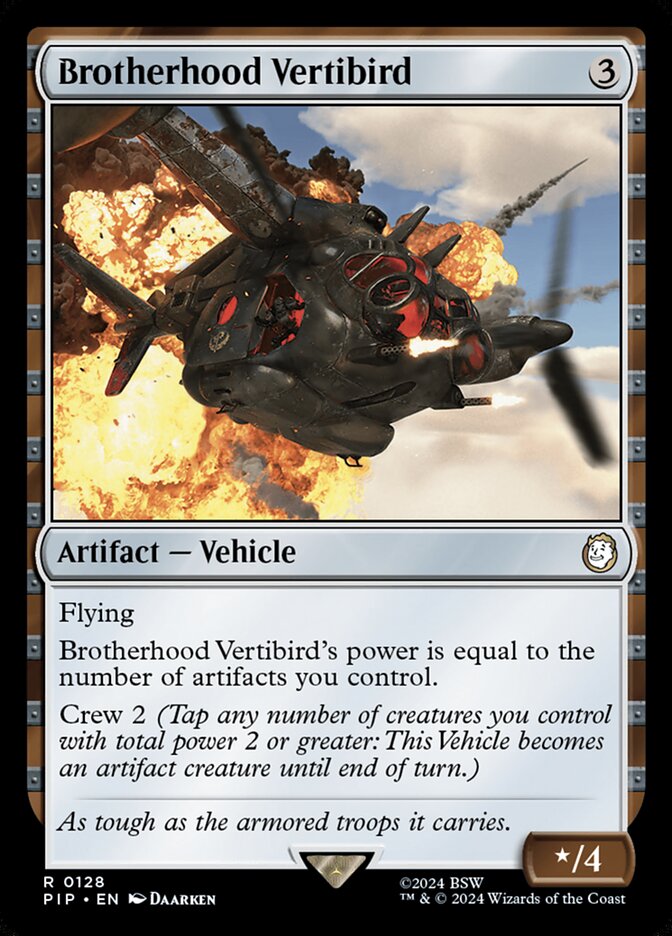
Brotherhood Vertibird
Steel Mentor: Vertibirds were the US military’s air support of choice in the days before the Great War sparked. Versatile little gunships, they were initially only seen the hands of Enclave forces during the events of Fallout 2 and 3, with the Brotherhood of Steel capitalizing on the Enclave’s defeat in the latter game to claim as many of them as they could and deploy them en-mass during their excursion into Boston. I guess you could say that the Power Equal to Artifacts represents the difficulties in maintaining these copters, as only the highest tech factions even get to breathe near one but it’s another stretch.
BPhillipYork: Mmmm this is okay, if you run a lot of artifacts/artifact creatures, fine, doesn’t really do anything interesting unlike a lot of neat vehicles.
Marcy: Well, how many artifacts do you have in your deck? That determines if this is a good vehicle or not.
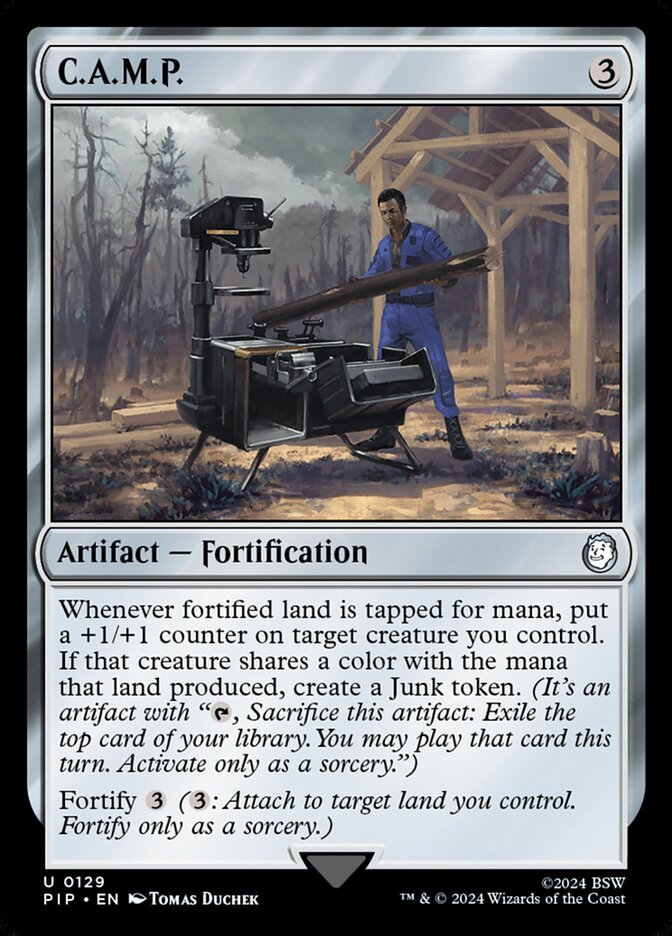
C.A.M.P.
Steel Mentor: Holy shit it’s Fortified. Universes Beyond brings out all the weirdest mechanics huh? Anyway, the C.A.M.P module is a portable workshop given to players in Fallout 76 as an all in one means of surviving and rebuilding after the nuclear hellfire. There’s no real depth of lore behind it, its a way for players to slap down their Fortnite-ass custom buildings and craft their way to victory.
BPhillipYork: Wow this is really a blast from the past (haha.. oh terrible) and this is much stronger than the other fortify ability. I thought that was totally abandoned forever, but here it is, a +1/+1 counter and a potential Junk token is really pretty nice, though 6 mana is really excessive. This will see far more play than it should, I would predict, and the decks that actually should run it (artifact token based, or multiply untapping lands based) won’t even bother because they are too cohesive.
Marcy:

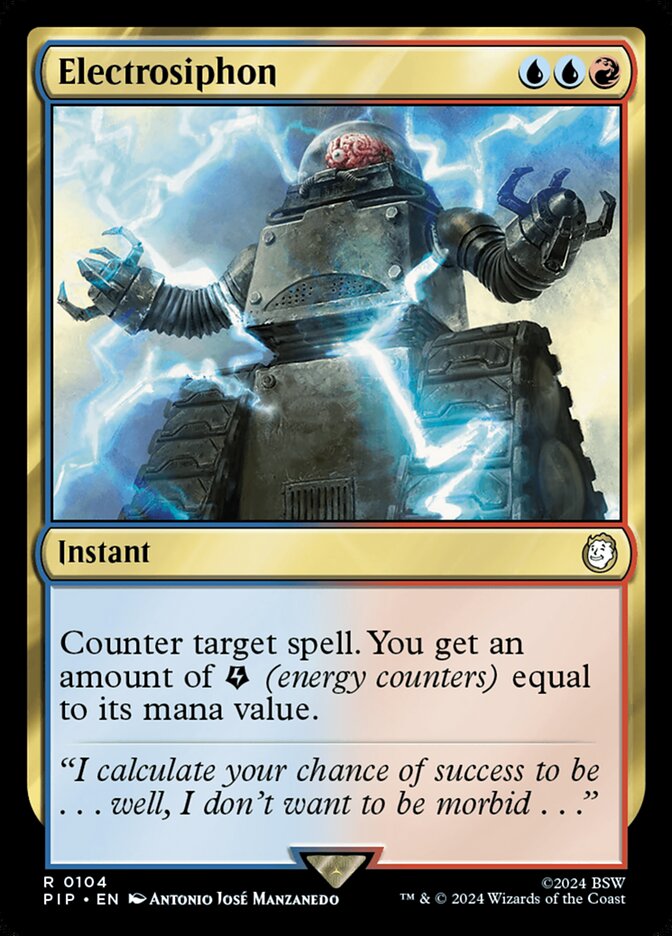
Electrosiphon
BPhillipYork: Neat. Not like, put it in your deck neat, but neat. Fine for any deck that cares about energy, obviously, then run, though it gives you an incentive to just counter something, anything.
Marcy: Honestly just a pretty solid counterspell. The Energy is probably negligible, except in a deck that cares about it, but for a Commander deck in at least Izzet colors, this is pretty solid.
FromTheShire: If your deck has blue in it you always want to toss at least one or two counters in it, and this has a great little on theme upside for this deck. Love these kinds of cards.
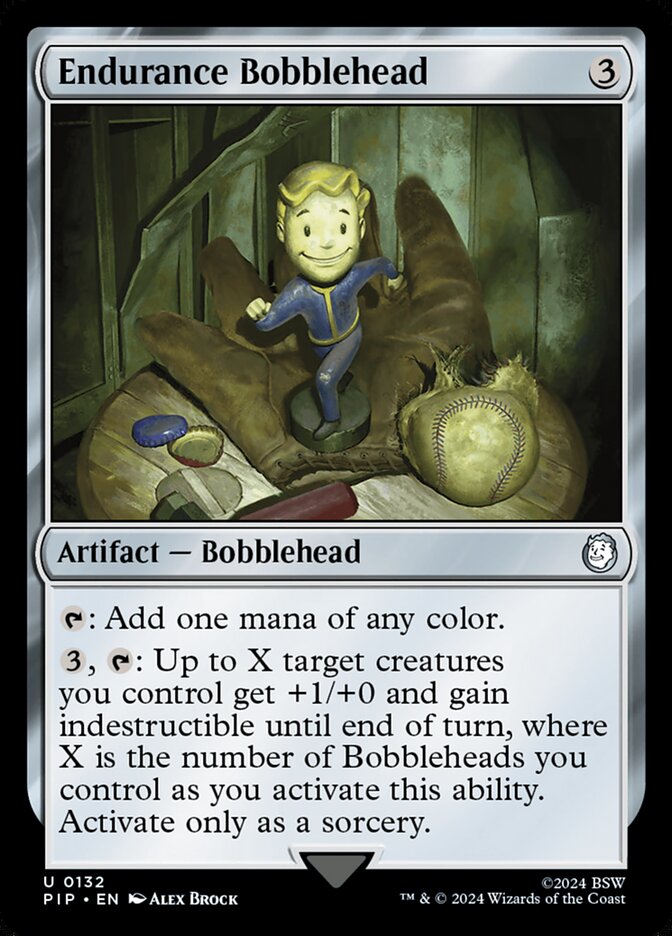
Endurance Bobblehead
BPhillipYork: Well up until the last line this is decent then it’s a sorcery so like… meh. Fine if you want to protect your board then wrath but that’s 7 mana. Which is about 4 too much for the effect.
Marcy: Since you can only activate as a sorcery, the value of this bobblehead decreases quite a lot in my eyes. Would be great if you could use it to protect against a board wipe, but you could also use it to make your own board wipes one sided.
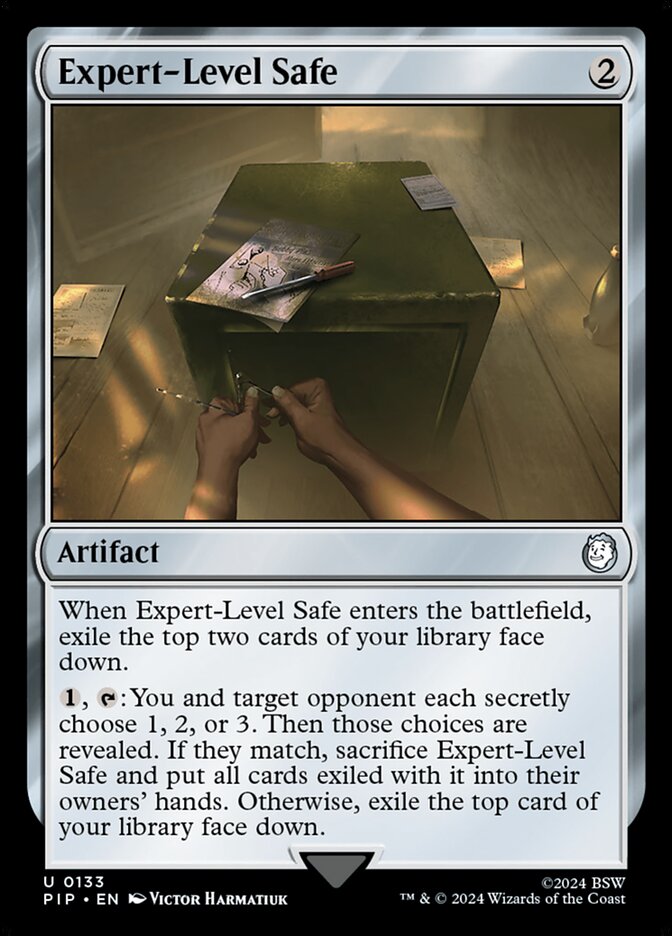
Expert-Level Safe
BPhillipYork: I like how this card is complicated and kind of annoying and also not that good.
Marcy: A cute card as long as people play along and don’t pretend, I suppose. Still, a cute little card that at least lets you play a small game with your opponent over the cards, and you can get some increased value.
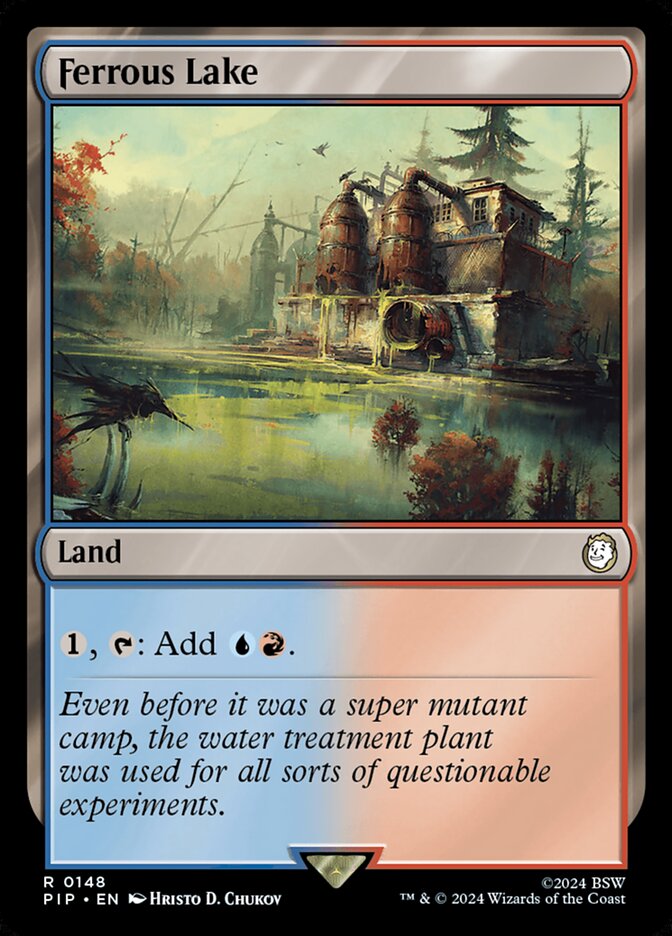
Ferrous Lake
Steel Mentor: I couldn’t quite figure which location this was supposed to represent from the games, but it seems to be referring to the origins of Super Mutants in Appalachia, with Vault Tec infecting the water supply of several towns with FEV and watching as said towns transformed slowly into Mutants before clearing them out and starting over. Pretty card though.
BPhillipYork: Uh, filter lands, always nice.
Marcy: Yep, filter land!
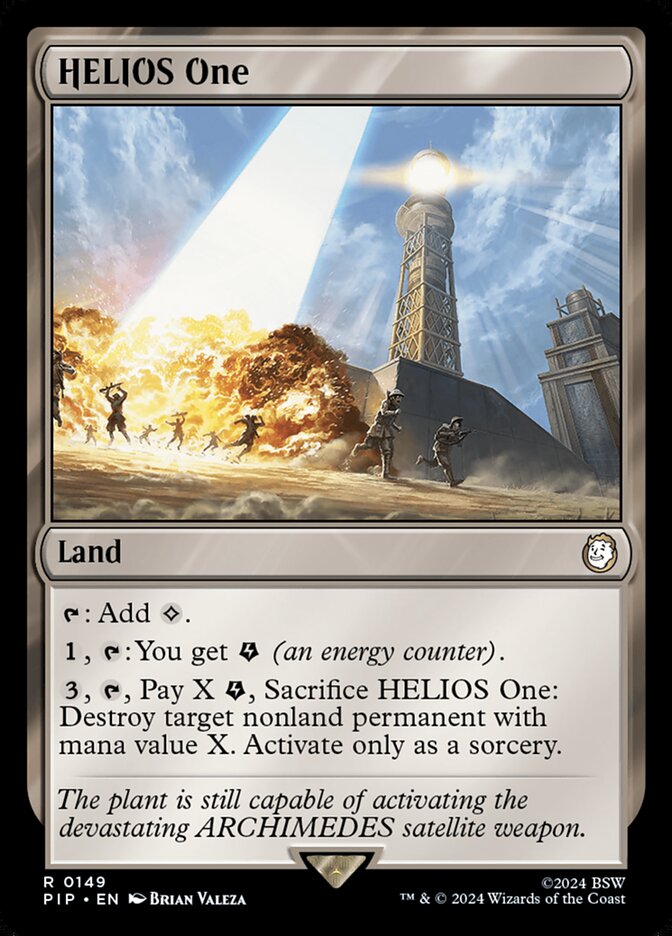
HELIOS One
Steel Mentor: A Solar Energy plant owned and operated by Poseidon Energy out in the middle of the Mojave. As you might expect from a something controlled by a corporation in the Fallout universe (and in real life, badumtish), it was a front for shady mad science. In this case, a satellite death ray that drew energy from the plant to scorch anything unfortunate enough to be under it. HELIOS One was found and refurbished by the Brotherhood of Steel, who were forced to abandon it when the NCR came knocking wanting the plant to supply their growing settlements with power, utterly oblivious to the giant death laser. The energy generation is pretty self-explanatory, as is its on-tap removal effect, though the sacrifice part of its cost is a pure balance decision.
BPhillipYork: Nice. Nice execution. Honestly just really nice story reference.
Marcy: HELIOS One is my favorite questline in New Vegas because the gun you get from it is my favorite weapon (as I mentioned, I used it to kill Caesar quite satisfyingly). I think this is so far the most fun colorless land in the set, and if you had some way to get it back from your graveyard after sacrificing it, this could be a real menace of a card.
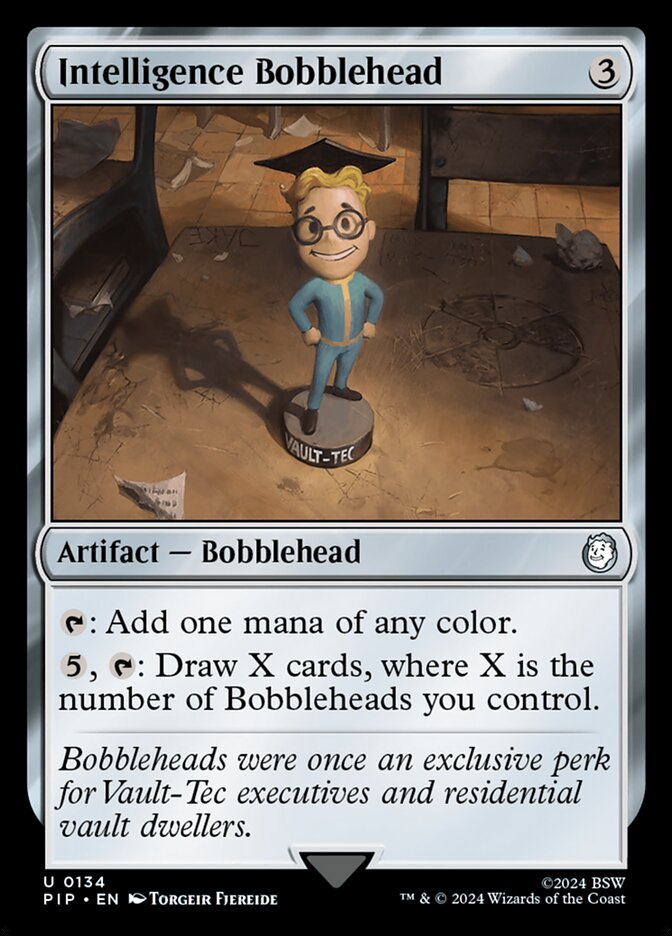
Intelligence Bobblehead
BPhillipYork: One of, if not the best, bobbleheads, but really expensive. So like you’d need all the other bobbleheads to pay for it.
Marcy: The 5 cost really kinda ruins this, because it requires you to have a number of Bobbleheads to make this work.
FromTheShire: It’s Commander, by the time you’re out of cards and want to be activating this, you definitely can afford to pay 5. Is it the best rate in a vacuum? No, but it’s also stapled onto an already useful mana rock and it scales, so. Very solid.
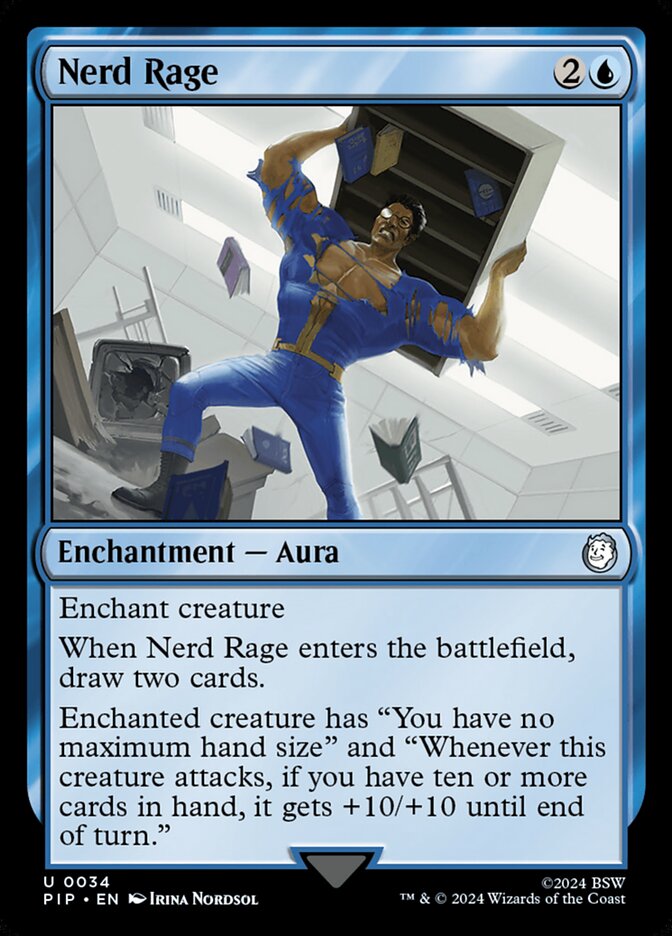
Nerd Rage
Steel Mentor: We’re back to Auras as Fallout Perks with one of the sillier Perks out there. Nerd Rage was added in Fallout 3 and has appeared since, giving characters that invested in enough Science and Intelligence stats a significant boost to their defensive and offensive abilities if their health dropped below the threshold. In that case it feels a little weird that the trigger for the Enchantment version buffing its attached creature is having excessive cards in hand rather than none to few. Would have been a more coherent 1:1 representation.
BPhillipYork: Funny perk into an aura, it’s not totally unplayable, decent if you have some low key flickering planned. But 10 or more cards in hand is pretty deeply into win more territory.
Marcy: This card is super fun, and also potentially really strong; Blue has so many ways to draw cards and protect your hand size, so growing some creature to a giant monster off of a grip of cards in your hand is quite feasible.
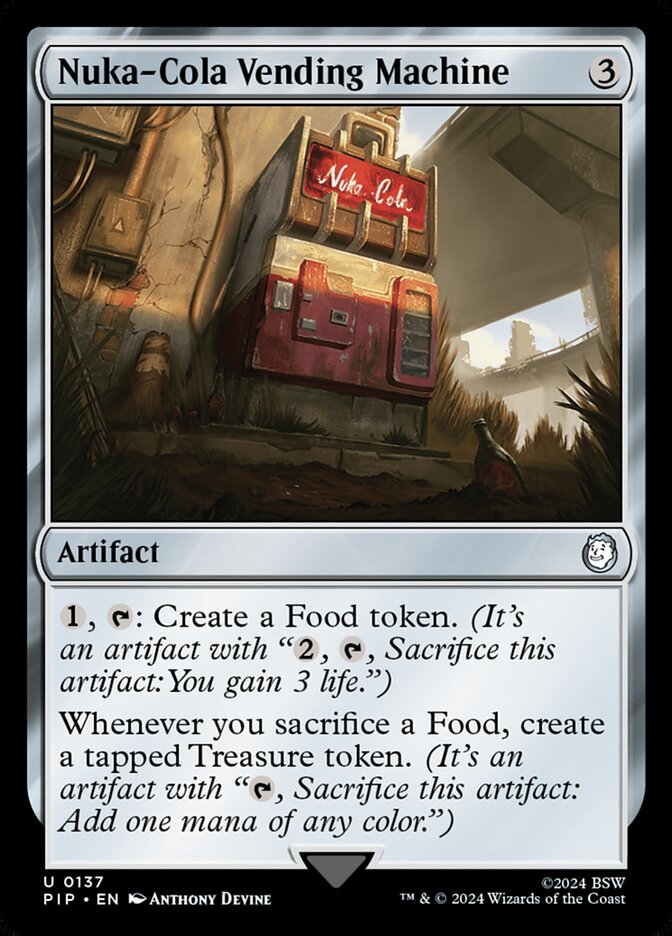
Nuka-Cola Vending Machine
BPhillipYork: Potentially really dangerous and also infinite with Academy Manufactor if you have a way to sacrifice artifacts, or Foods specifically for free. Which feels kind of Fallout-y in a weird way.
Marcy: Well, flavor aside (in Fallout, you get a cap from drinking a Nuka Cola), there’s some potential in abusing this thing in combination with Food tokens, and we all know Food tokens have never been abused in Magic the Gathering ever.
FromTheShire: Really great, especially in decks that care about artifacts or tokens. An artifact that makes artifacts that make further artifacts, all while gaining you life and mana and almost certainly being doubled or sacrificed for value or abused in some other way.

Overencumbered
Steel Mentor: We’ve gone from Auras as Perks to Auras as Debuffs for our final example. Overencumbered is a status every player learns to hate, triggering when your inventory weight exceeds how much your character can carry, disabling fast travel and significantly slowing you down. And in a game series that encourages you to steal everything not nailed down in case you can find a use for it later… yeah, it sucks. 10/10 card design, perfect for annoying the shit out of your opponents.
BPhillipYork: Very nice reference, and a cool way of working out how to handle this in game terms. Only real downside I see is you are locking only one player out of attacking most likely, so far more limited than War Tax, although it does better protection for planeswalkers, this protects not just you but also your non-enchanted opponents, which is a pretty severe downside.
Marcy: This feels like a hilarious addition to a Stax deck of some sort. And frankly, Commander tends to run a ton of artifacts, so this is going to be an annoying card to get rid of, even worse if you can copy it.

Plasma Caster
BPhillipYork: The nice thing about this is it will cause your creatures to probably just not be blocked, but for 4 mana that’s not really good enough. If you’re using this as a combo piece to generate energy for extra turns or additional combats, then it’s dangerous.
Marcy: Who doesn’t love coin flips? Me, really, but I do enjoy the idea of this card, and I do also at least like that you generate energy off of it.
FromTheShire: Solid energy generator in general, even if you’re not using it as removal.
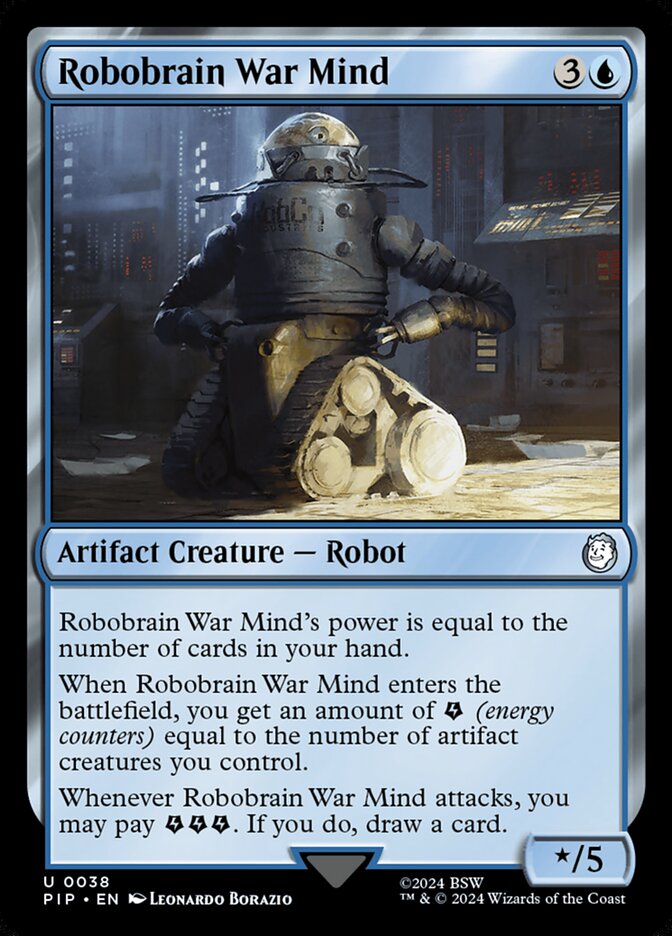
Robobrain War Mind
Steel Mentor: Robobrains were but one of RobCo’s experimental forays into the realm of cybernetics, cyborgs created from prisoners obtained through RobCo’s contracts with the US Government. While the reprogramming tended to keep most Robobrains from going murderously mad at the realization of what they’d been transformed into, hundreds of years without maintenance has completely circumvented such failsafes, leaving even most non-hostile Robobrains a little bit loopy. Flavourwise it’s pretty much what you’d expect from WotC’s typical blue artifact creature, it loves cards in hand and other artifacts. Safe design, a little generic.
BPhillipYork: This is okay, pay 4, then probably next turn draw a card, possibly subsequent turns. Pretty durdely and not particularly big or evasive, so kind of meh.
Marcy: Again, do you have a lot of cards in your hand? Are you playing Blue? Then the answer is yes, and this thing is going to be a beater.

Sentry Bot
Steel Mentor: Another of RobCo’s line of military robots, Sentry Bots are heavy weapons platforms with enough firepower to blast away many times their number in enemy combatants. Sentry Bots never made it into mass production the same way other military robots did, restricting them to defending important military and industrial sites. In the post-nuke world tend to be seen being deployed by The Enclave, and then later The Brotherhood, acting as a tough late game enemy when encountered hostile. The first three abilities on this card do a good job kinda representing the Fallout Sentry Bot in its role, but the last one makes me tilt my head. A little bit of the “we want to use this card name at a later date” I suspect.
BPhillipYork: Pretty solid, slam out to get some energy and then pump your weenies later and also get a cheap block off.
Marcy: I guess if you could use the energy on someone else’s turn, this would be really busted, but as it is, this isn’t a bad thick butt to throw in front of an attacking creature. Unfortunately, it also costs 5 mana.

Synth Eradicator
Steel Mentor: As mentioned in Nick Valentine’s entry above, Synths are advanced androids developed by The Institute, the descendants of MIT scientists who holed up underground and have been playing around with advanced tech as the survivors on the surface fought tooth and nail to survive. As you might expect from a bunch of STEMlords, The Institute really doesn’t see much of a problem with taking what it wants from those outside their group, sending Synths like the Eradicators to rough up and brutalize surface dwellers pretty casually.
BPhillipYork: I think the exile/play effect is the real gem here, and I like that there is a payoff for not playing the card, though you have to have some way of using the energy, it’s a nice interaction, but at 3 mana a bit pricier than really efficient sources of impulse draw.
Marcy: Another solid card in a Cares About Energy deck, the choice to generate Energy or get card advantage is really solid. But in a deck that doesn’t use Energy or generate it in any other way, this card loses a lot of value.
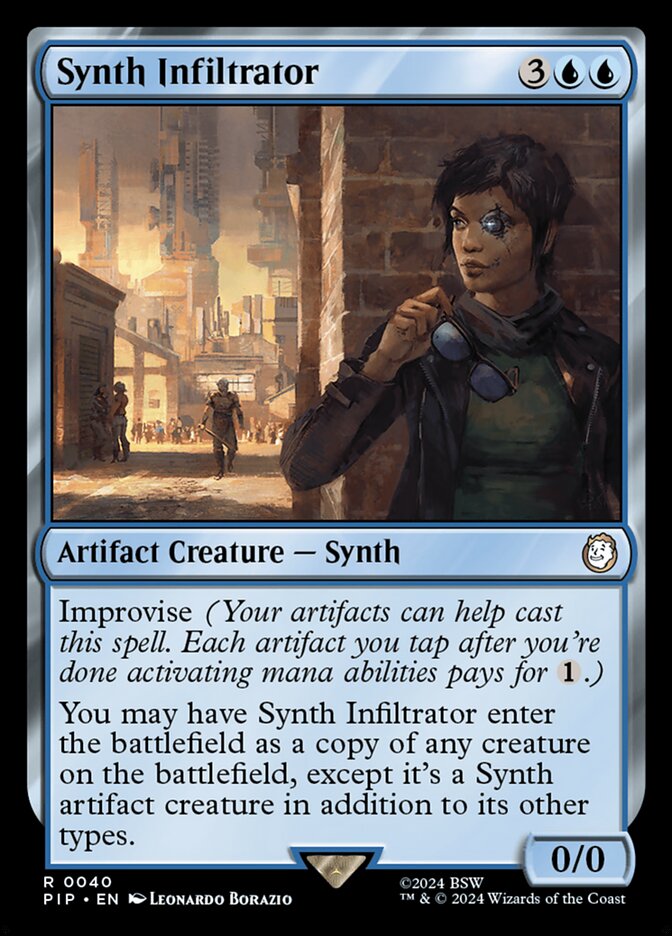
Synth Infiltrator
Steel Mentor: As time went by and The Institute grew more aware of the world outside Boston, concern over groups such as The Brotherhood of Steel convinced The Institute to start taking a less blunt approach to retrieving valuables from their fellow Bostonians, with the more advanced generations of Synths proving ideal for the task. Synth Infiltrators began replacing key individuals in important settlements, most not even aware they were Synths but compelled to further their masters’ agenda subconsciously. By the time the player character makes their way to Boston proper in Fallout 4, settlements like Diamond City are gripped in a deep paranoia of Synth sleeper agents, witch hunting anyone vaguely acting a little off out of sheer fear.
BPhillipYork: Yeah this is a very good clone copy, I like it a lot.
Marcy: For the likely cost of 2 blue, you get a copy of anything you want. Pretty good.
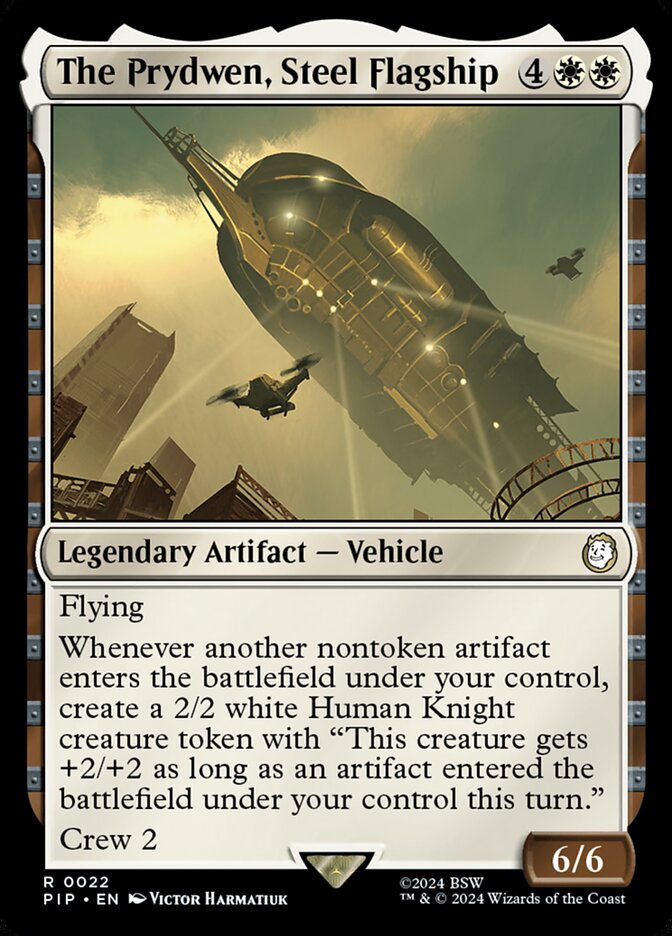
The Prydwen, Steel Flagship
Steel Mentor: When the Brotherhood of Steel decided to march into Boston, they decided to make their entrance one to behold. A rare example of new technology being developed, The Prydwen was designed and built by the East Coast Brotherhood as a mobile base and air carrier, allowing them to range out far further than their Citadel in the Capital Wastes. It’s a big flying vehicle, it makes Artifact Matters creatures when Artifacts are dropped. It’s a damn clean and cool card design.
BPhillipYork: I like how well this fits into like a random Knight deck, it doesn’t really scream Brotherhood of Steel to me, and it costs 6, but it nicely doesn’t really care about being crewed or attacking which a lot of vehicles do. Feels a bit like it should have Knight improvise or something like that to lower the cost.
Marcy: Pretty solid, especially in a deck where you get a lot of artifacts onto the board, you might start creating a tide of tokens, as well as tokens that buff themselves.
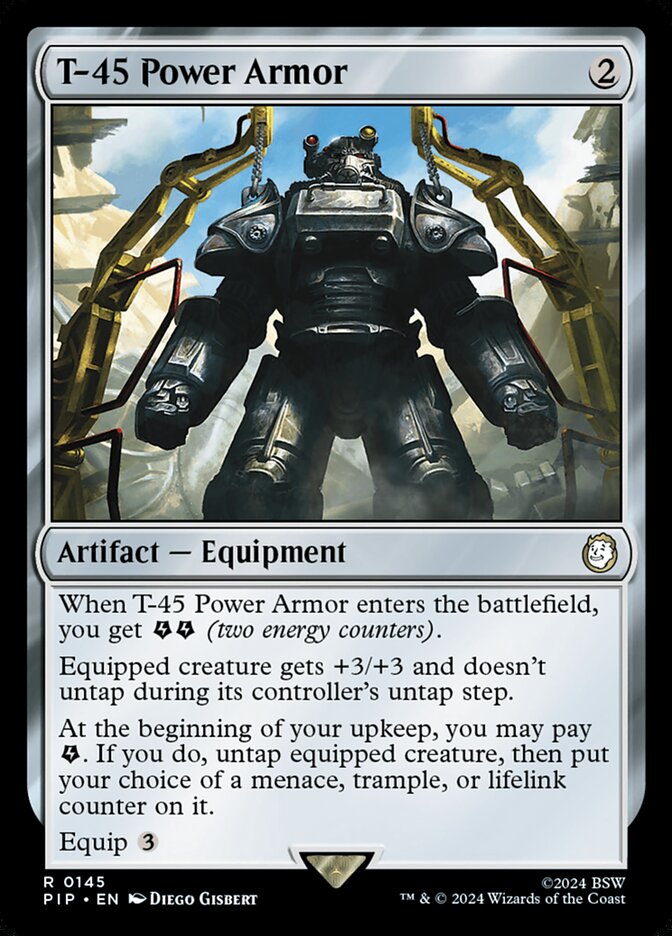
T-45 Power Armor
Steel Mentor: Can you believe its taken us this long to talk about Power Armour? Developed as a means to match the China’s armoured superiority while taking into account the difficulties in deploying traditional armoured vehicles with the scarcity of fuel, Power Armour transforms the wearer into a walking tank, capable of smashing through buildings and wading through incoming fire with ease. T-45 mark is the variant introduced for Fallout 3 and has went on to pretty much become the iconic mark for the entire series, appearing the most in games and marketing since. In terms of a card, it does well in portraying the advantages and disadvantages of Power Armour, granting big bonuses… but only if you can keep the thing running and powered up.
BPhillipYork: Kind of a strange execution IMO, but if you for some reason want to keep getting those counters to make some neat interaction work, this is fine enough. But it’s so expensive that I fail to see how it really clears the bar.
Marcy: Well, getting to the actual iconic power armor of the series, or at least of Fallout 4, this is… kind of underwhelming, I suppose? Sure you get +3/+3, but unless you can generate Energy, you’re going to have about 2 turns of this being useful on the offensive.

Vault 13: Dweller’s Journey
Steel Mentor: Our last pair of Sagas for this set starts us with Vault 13, the home to the first game’s Vault Dweller. Vault 13 really isn’t that interesting a Vault, it was designed to have its water chip fail and wasn’t issued replacements and that’s it, so leaning on the broad strokes of the story of Fallout 1 is a pretty decent angle to lean on. That said… I just don’t think this is a good card, either mechanically or flavour wise. A big miss.
BPhillipYork: Interesting card, kind of card advantage if you can get rid of it before the 3rd chapter you can exile stuff forever, unfortunately you cant just exile your own creature that flickers an enchantment to create a loop because of the state-based check that occurs once the chapter 3 triggered effect leaves the stack.
Marcy: A little confusing, and honestly, if you aren’t using this in a game with more than 2 players, probably kind of worthless.

Vault 112: Sadistic Simulation
Steel Mentor: On the other hand, Vault 112 is a slam dunk. This Vault was designed by one Dr Braun, a reward from Vault Tec for developing the Garden of Eden Creation Kit. Installed with experimental full immersion Virtual Reality pods, Braun trapped the Vault’s residents within the collective simulation and spent the next few hundred years torturing and murdering them over, and over, and over again, their physical forms kept alive indefinitely. Directed into the Vault during the story of Fallout 3, players are forced into the simulation and must contend with Braun’s sadistic games. The first part of the card is great, while the second part is a little more abstract in representing beating the simulation. Pretty cool to see it represented at all to be honest.
BPhillipYork: Chapter 3 is mediocre since you can’t control the card you will play for free, it’s liable to be a land when you want Omniscience.
Marcy: Oh hey look it’s Aetherworks Marvel with extra steps.
That wraps up our look at the fourth preconstructed deck. Join us next time as we return to our regular content! In the meantime, if you have any questions or feedback, drop us a note in the comments below or email us at contact@goonhammer.com.

